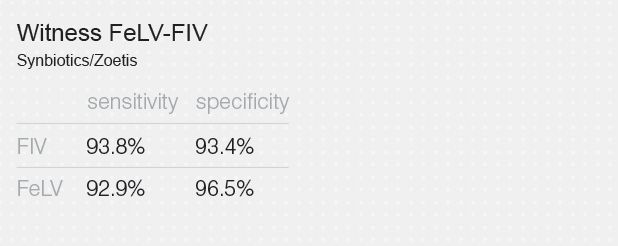Understanding Retrovirus Test Sensitivity and Specificity
Diagnostic test sensitivity refers to the likelihood that the test will correctly diagnose a positive cat as positive. Diagnostic test specificity refers to the test’s ability to correctly diagnose a negative cat as free from a given disease.
Sensitivity and specificity are typically reported in large percentages, but what can these figures actually tell us? What are the practical consequences for the care of cats?
To illustrate, we’ve taken data that Synbiotics/Zoetis provided to the USDA in support of their license for the Witness FeLV-FIV Test (below)1,2 and applied it to illustrate what it could mean for your diagnoses and decision making:

The probability of misdiagnosing negative cats (specificity)
A negative cat is defined as one that is negative for both FIV and FeLV. A positive result for either FIV or FeLV would result in a misdiagnosed negative cat (in other words, there are two ways of misdiagnosing any given negative cat). Since the two tests are independent and the two disease states are independent, probability theory gives us the following equation for total specificity:3
SpFIV and FeLV = SpFIV × SpFeLV = 0.934 × 0.965 = 0.90131
This gives a false-positive rate of 1 – SpFIV and FeLV = 1 – 0.90131 = 0.09869 or 10%
Applying data from Synbiotics/Zoetis, probability theory tells us that as many as 1 in 10 negative cats could have one or more false-positive results for FIV, FeLV or both using the Witness test.
The probability of misdiagnosing positive cats (sensitivity)
A positive cat is defined as one that is positive for either FIV or FeLV, or both. The determination of total sensitivity4 in this case is more complicated.5 To approximate the number of cats positive for FIV or FeLV that will have a false-negative result, we consider the sensitivity of the test for FIV and for FeLV separately, and then combine them. (In this approximation analysis, a dual infection case—a cat that is positive for both FIV and FeLV and misdiagnosed—is ignored as it is rare and its incorporation in the calculation doesn’t substantively alter the result.6)
Probability of a false negative for an FIV-positive cat = 1 – SeFIV = 1 – 0.938 = 0.062 or 6.2 cats for every 100 FIV-positive cats
Probability of a false negative for an FeLV-positive cat = 1 – SeFeLV = 1 – 0.929 = 0.071 or 7.1 cats for every 100 FeLV-positive cats
Unlike the above, there is only one way to misdiagnose a given cat that is positive for FIV (and likewise for FeLV). To address this, we combine the two probabilities by summing the number of false-negative cats and the total number of cats:
6.2 out of 100 and 7.1 out of 100 = (6.2 + 7.1)/(100 + 100) = 13.3/200 = 0.0665 which suggests that as many as 1 in 15 FIV- or FeLV-positive cats could have a false-negative result using the Witness test.
References:
- Witness FeLV-FIV Test Kit [product page]. Zoetis website. www.zoetisus.com/products/cats/simplysmarterchoice.aspx. Accessed February 9, 2015.
- Zoetis Launches New Witness FeLV-FIV Combination Test [press release]. www.zoetisus.com/news-and-media/zoetis-launches-new-witness-felv-fiv-combination-test.aspx. Accessed February 9, 2015.
- Weiss NA. Introductory Statistics. 9th edition. Boston, MA: Pearson Education; 2012:184.
- Weiss NA. Introductory Statistics. 9th edition. Boston, MA: Pearson Education; 2012:165.
- The full calculation that includes the dual-infection case is available upon request.
- Levy JK, Scott HM, Lachtara JL, Crawford PC. Seroprevalence of feline leukemia virus and feline immunodeficiency virus infection among cats in North America and risk factors for seropositivity. JAVMA. 2006;228(3):371–376.
Introductory Statistics is available on line at http://202.114.108.237/Download/4ad56511-0538-47b1-9c39-0aff5c3f6403.pdf.